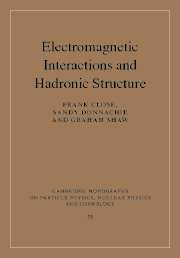Book contents
- Frontmatter
- Contents
- List of contributors
- Preface
- 1 Quark models of hadrons and issues in quark dynamics
- 2 Elastic form factors
- 3 Electromagnetic excitations of nucleon resonances
- 4 Meson radiative decays
- 5 Intermediate-energy photoproduction
- 6 Chiral perturbation theory
- 7 Spin structure functions
- 8 Diffraction and colour dipoles
- 9 Generalized parton distributions
- 10 Quark–hadron duality
- 11 Colour transparency
- Index
7 - Spin structure functions
Published online by Cambridge University Press: 15 August 2009
- Frontmatter
- Contents
- List of contributors
- Preface
- 1 Quark models of hadrons and issues in quark dynamics
- 2 Elastic form factors
- 3 Electromagnetic excitations of nucleon resonances
- 4 Meson radiative decays
- 5 Intermediate-energy photoproduction
- 6 Chiral perturbation theory
- 7 Spin structure functions
- 8 Diffraction and colour dipoles
- 9 Generalized parton distributions
- 10 Quark–hadron duality
- 11 Colour transparency
- Index
Summary
This chapter deals with properties of hadrons in high-energy scattering processes with special emphasis on spin dependence. We consider electroweak interactions, specifically lepton–hadron scattering that allows a separation of the scattering amplitude for the reaction into a leptonic part and a hadronic part, where the leptonic part involving elementary particles is known. The structure of the hadronic part is constrained by its Lorentz structure and fundamental symmetries and can be parametrized in terms of a number of structure functions. The resulting expression for the scattering amplitude can be used to calculate the cross sections in terms of these structure functions and, in turn, a theoretical study of the structure functions can be made. Part of this can be done rigorously with the only input, or assumption if one prefers, the known interactions of the hadronic constituents, quarks and gluons, within the standard model. For this both the electroweak couplings of the quarks needed to describe the interactions with the leptonic part via the exchange of photon, Z0 or W± bosons, as well as the strong interactions of the quarks among themselves via the exchange of gluons are important. For a general reference see the books of Roberts [1] or Leader [2].
Leptoproduction
In this section we discuss the basic kinematics of a particular set of hard electroweak processes, namely the scattering of a high-energy lepton, for example an electron, muon or neutrino, from a hadronic target, (k)H(P) l(k)X.
- Type
- Chapter
- Information
- Electromagnetic Interactions and Hadronic Structure , pp. 271 - 314Publisher: Cambridge University PressPrint publication year: 2007

